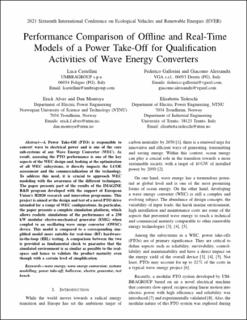Performance Comparison of Offline and Real-Time Models of a Power Take-Off for Qualification Activities of Wave Energy Converters
Castellini, Luca; Gallorini, Federico; Alessandri, Giacomo; Alves, Erick Fernando; Montoya Andrade, Dan El Andres; Tedeschi, Elisabetta
Chapter
Accepted version

Åpne
Permanent lenke
https://hdl.handle.net/11250/2823032Utgivelsesdato
2021Metadata
Vis full innførselSamlinger
- Institutt for elkraftteknikk [2468]
- Publikasjoner fra CRIStin - NTNU [38127]
Originalversjon
10.1109/EVER52347.2021.9456630Sammendrag
A Power Take-Off (PTO) is responsible to convert wave to electrical power and is one of the core sub-systems of any Wave Energy Converter (WEC). As result, assessing the PTO performance is one of the key aspects of the WEC design and, looking at the optimization of all WEC subsystems, it directly impacts the LCOE assessment and the commercialization of the technology. To address this need, it is crucial to approach WEC modeling with the awareness of the different techniques. The paper presents part of the results of the IMAGINE R&D program developed with the support of European Union’s H2020 research and innovation programme. This project is aimed at the design and test of a novel PTO drive intended for a range of WEC configurations. In particular, the paper presents a complete simulation platform, which allows realistic simulations of the performance of a 250 kW modular electro-mechanical generator (EMG) when coupled to an oscillating wave surge converter (OWSC) device. This model is compared to a corresponding simplified model more suitable for real-time (RT) hardwarein- the-loop (HIL) testing. A comparison between the two is provided as fundamental check to guarantee that the simulated environment is as similar as possible to the realspace and hence to validate the product maturity even though with a certain level of simplification.